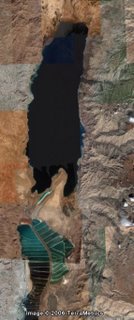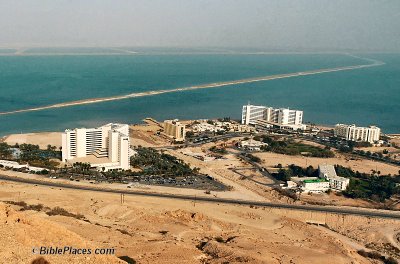 Yes, it’s true – the Dead Sea’s falling threatens the environment and the roads, and the Dead Sea’s rising threatens the hotels. How one sea can be both rising and falling at the same time is best explained this way: there are two Dead Seas.
Yes, it’s true – the Dead Sea’s falling threatens the environment and the roads, and the Dead Sea’s rising threatens the hotels. How one sea can be both rising and falling at the same time is best explained this way: there are two Dead Seas.
Until modern times, the Dead Sea was a 50-mile (78-km) long body of water, with a piece of land sticking out from the eastern side. Because it apparently looked like a tongue, it was called that in Hebrew (lashon) and Arabic (lisan).
With the damming of the Sea of Galilee and the use of water that formerly flowed down the Jordan River into the Dead Sea, the level of the Dead Sea dropped in the 20th century until the tongue reached all the way across the lake. The southern end is shallow and would have completed dried up if not for the channeling of water by the company that extracts minerals from the Dead Sea waters. So the southern end today is essentially an artificial evaporation basin, connected to the northern end only by manmade channels.
Today the northern end continues to drop because the limited inflow of water from the Jordan River. The southern end, however, is rising, because of the activities related to the mining of minerals. The rise of approximately 8 inches a year (20 cm) is now threatening the tourist resort of Ein Bokek and its many hotels.
 Hotels of Ein BokekAccording to Haaretz, the Supreme Court of Israel has ordered the government to come up with a plan to solve this problem.
Hotels of Ein BokekAccording to Haaretz, the Supreme Court of Israel has ordered the government to come up with a plan to solve this problem.
At present, there are three options: building a new lagoon with walls that will prevent flooding of the reservoirs, removing the extra salt from the bottom of the reservoirs or demolishing all hotels on the Dead Sea shore and rebuilding them in alternative locations.
In the meantime, expect the Dead Sea to continue to rise and fall simultaneously.
2 thoughts on “The Rise and Fall of the Dead Sea”
TODD: Very interesting. Yes, this is one of the more curious facts I ran across in our tour guide course: that the surface of the southern “basin” — which, as you say, is now totally artificial — lies at a higher elevation than the northern. Water is actually pumped upward, some 10 to 15 meters I believe, into the evaporation ponds. There, the precipitation and accumulation on the bottom of unwanted minerals keeps the level of the whole system constantly rising, the pools contained within ever-growing berms or dikes — OF SALT!
Why don’t they pump in some sea water from the Gulf of Aqaba?
They would have to only move the water up 200 meters and over a distance of 200 kilometers.
By increasing the water level; the surface area of the Dead Sea will increase; which will allow more evaporation; which will put more water in the atmosphere; which will give more rain to the Jordan desert; which will give fresh water to plants, animals and people; much of which will ultimately return to the Dead Sea via natural processes.
Sounds like a win-win situation for all.